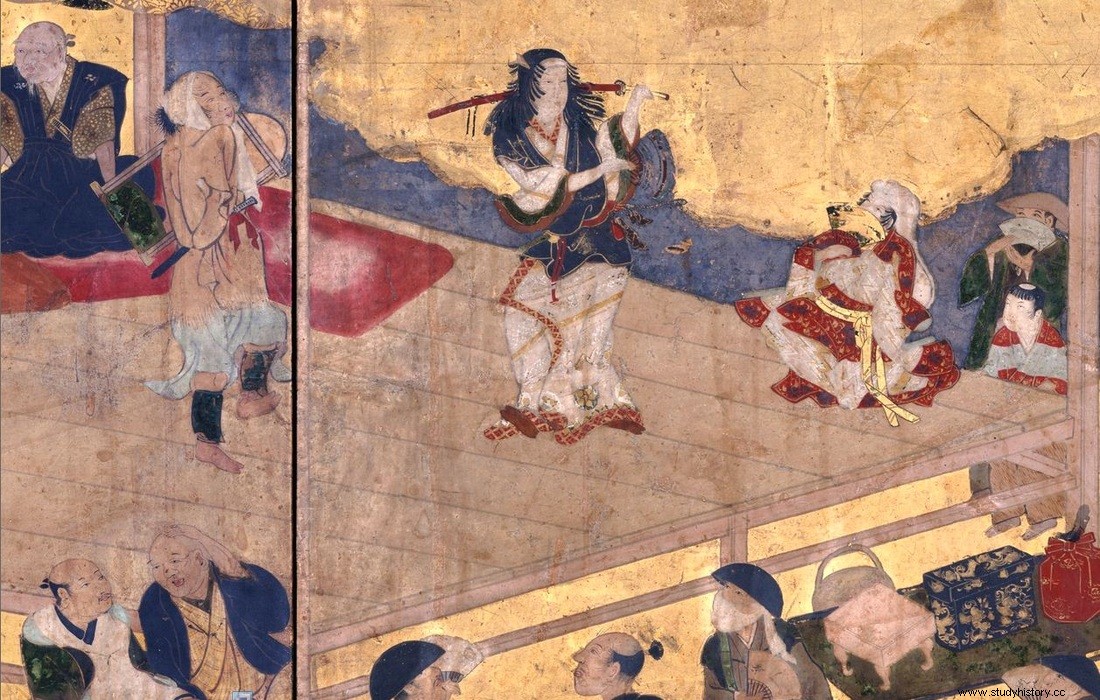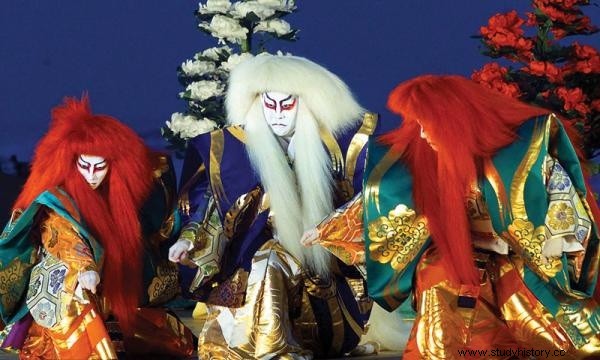It is known that in kabuki , one of the classic forms of Japanese theatre, cannot be performed by women, and the female roles are played by transvestite men who often turn out to be more feminine than the very ladies they are trying to imitate. They are the onnagata , ambiguous and provocative figures that have been raising passions among the public (of both sexes) for centuries. But this was not always so. There was a time when kabuki performers they were mainly women, and in fact this theatrical form was originally created by a female. The legendary Okuni , priestess of the grand shrine of Izumo and itinerant dancer in her spare time, was the one who pulled out of her sleeve this bizarre style of theater that combines dance and pantomime. What the hell happened so that women ended up banned from the show they themselves had invented?

onnagata
We are at the dawn of the Edo era, with the newly unified country under the aegis of the Tokugawa shogunate. The Japanese know peace for the first time in decades, and in cities like Kyoto and Osaka a thriving bourgeoisie, eager for entertainment and fun, begins to prosper. These are good times for arts and culture. This is where Izumo no Okuni enters the scene, never better said. , as it is popularly known. At the head of a group of comedians, all women, Okuni traveled the country selling her art. They say that initially these tournées were simply to raise funds for the Izumo shrine. . But, seeing the success that she reaped, the priestess soon ended up dedicating herself to show business full time. The members of the Okuni troupe were very dressed-up girls, who would perform a folkloric dance, recite a poem or offer to ease your pain for a modest price. And yes, alleviating pain was in the literal sense:Okuni's cadre of actresses was made up mostly of prostitutes, and her performances, in essence, were nothing more than a somewhat flashy way of advertising herself to potential customers. In Japan at the time, Okuni's "extra" services and her dancers were nothing out of the ordinary. What was truly surprising was the previous show. In reality, Okuni probably didn't invent anything radically new, and she simply adapted a number of trendy dances giving them her personal touch. But she, for some reason, knew how to hit the right key to connect with the public, and that was the embryo of what would eventually become the kabuki theater .

Okuni and her primal kabuki
The first recorded performance of kabuki took place in 1603 in Kyoto, along the Kamo River bed, at the height of the great bridge on Shijo Avenue. It would be the first of many. A few years later, the popularity of kabuki was such that Okuni had already toured the country several times. In 1607 she even performed at Edo Castle, before the Shogun himself. Okuni's meteoric rise and her kabuki seemed to have no end. Soon new theater companies sprang up like mushrooms that copied and developed the formula she invented.
These early performances were a fairly simple, dance-based show with a rather minimal story. Nor was much more needed, let's not forget that the main objective of the show was to show the "merchandise" and that the clients would then bid to take her favorite dancer to the cot. But, beyond the festive erotic component of that theater, its transgressive look and that provocative style of storytelling were going to go deep. It must be said that kabuki as we know it today has evolved a lot since then. Always seeking to leave the viewer open-mouthed, it has become more and more excessive:impossible wigs and costumes, exaggerated poses, bizarre makeup... Everything is excessive and overwhelming to the point of absurdity . But what has not changed is its markedly popular character, a show made by and for the people, very different from the stylized (and boring) noh theater. . In kabuki, it is common for the respectable to cheer on his favorite heroes and boo the villains in the middle of the performance, unscripted jokes are the order of the day, and it is the norm of the house that the actors sneak into the courtyard of seats to excite the public. His transgressive and thug spirit remains the same since the days of Okuni's vaudeville.
In addition, that extravagant and countercultural aesthetic was groundbreaking for his contemporaries. Chronicles say that, in her performances, Okuni herself often dressed as a man and wore palmetto sheathed in Western clothing that left the respectable with their eyes wide open:colorful capes, wide-brimmed feathered hats, and even rosaries topped by crucifixes. jeweled, imitating those of the Jesuit missionaries. The hipsters of feudal Japan, who have been modern throughout the ages, enthusiastically embraced this style and made it their flag . Fashion soon transcended the stage and became a true social phenomenon. There were even urban tribes that imitated the mannerisms and aesthetics of kabuki. The fever was spreading like a pandemic across the country, unleashing passions so heated that they threatened to erupt into real fires.

And it is that these actresses caused a real furor, which was a constant source of altercations among their fervent fans. Let's imagine what it would be like today to go to the cinema knowing that, at the end of the function, one has the opportunity to benefit from the Angelina Jolie or Charlize Theron shift. The riots and fights at the foot of the stage to get the favors of the star of the moment were the daily bread. And, in a society where a third of the population does not go out on the streets without their swords at their belts, the risk of tragedy when someone goes overboard is evident. To avoid greater evils, in 1629 the authorities decided to intervene and prohibited women from performing in the kabuki.
But, as it soon turned out, the cure was worse than the disease. As much as women were banned, performances still needed female roles. And what a remedy, from now on those would have to be interpreted by men. Preferably young and beautiful ephebes who could pass for young ladies without much makeup. They were the onnagata , and with them came the scandal.

onnagata
These cheeky medieval drag queens left Conchita Wurst and other drag queens of our days at the height of the mud. The onnagata they finished unleashing the lowest instincts of the Japanese public. Now it wasn't just the men who lost their heads and their wallets over the star of the day, but also the ladies who went crazy with those handsome young men dressed as geisha. And there were not a few actors who, seeing the panoja that moved there, took advantage of their popularity to rent themselves as bedfellows to the highest bidder... or bidder. Between one thing and another, far from being resolved, the disturbances around the theaters only worsened. The authorities, seeing that things were getting out of hand, decided to cut to the chase and ban female characters in kabuki plays. They also vetoed the participation of boys of deserving age in the cast of actors. Without women, without young men, and with all the roles played by men with gray hair, the once dazzling kabuki ran the risk of becoming an infamous show .
But the shogunate backfired. Scenes continued to be seen on stage as lewd as before, only now the love stories were all homosexual in nature. Male relationships weren't taboo in medieval Japan, but that wasn't exactly the kind of uplifting entertainment the government wanted to promote among the people. In addition, in practice, theatrical managers passed the prohibitions through the lining of the kimono, and always found a way to slip it folded into the censors. They even managed to cast strange ladies in the cast of actors, generally dressed as men. Didn't you want broth? So two cups. Thus, after several attempts, the Shogun's ministers saw that it was impossible to put doors to the field and they surrendered. As a lesser evil, they had to admit men in female roles. Girls would definitely be banned from kabuki from then on (as actresses, not spectators), but the onnagata they had come to stay.
As we can see, in the Land of the Rising Sun, the fascination with cross-dressing and young men with such delicate features that they look like girls is something that comes from afar. Already in his own mythology we find numerous examples. Even today, the stories of love affairs between sycalyptic and ethereal ephebes in comics and television series continue to stir passions among Japanese… and Japanese women. Although the taste for sexual ambiguity is not limited exclusively to male roles. It is seen that in Japan they are committed to equality, because they also have a long tradition of women cross-dressing as men in novels, dramas and comics of the most diverse fur. Without going any further, there is the Takarazuka theater , a musical variety show that, apart from sequins, is the other side of the coin of traditional kabuki, since in it all the roles, male and female, are played by women. As they say:for tastes, colors. Just like the rainbow.
Collaboration of R. Ibarzabal
Sources:Male Colors:The Construction of Homosexuality in Tokugawa Japan – Gary Leupp; Kabuki ga Wakaru Hon – University of California Press
